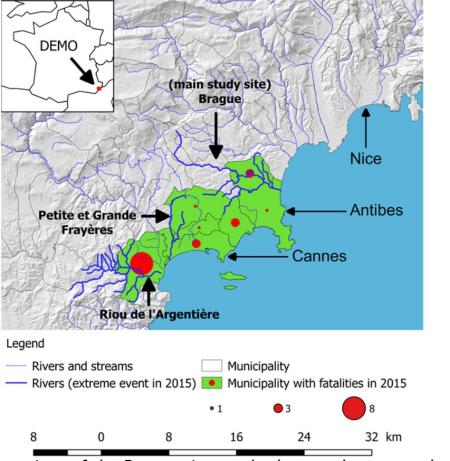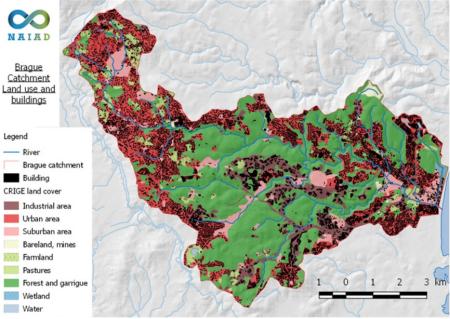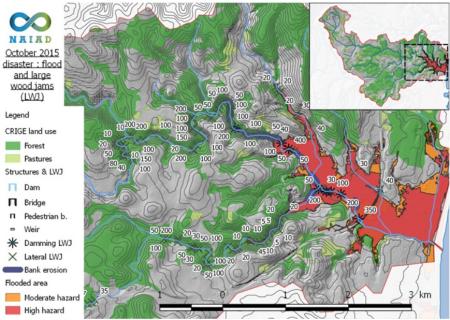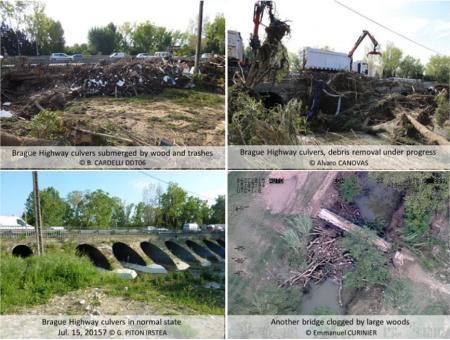
Area characterisation:
The Brague catchment region is located along the Mediterranean coast. A quite dense urban belt is located aside the shore, where all hilly catchments finish their way to the sea.
On 3rd, Oct. 2015, severe rainfalls triggered dramatic floods. Twenty peoples died, 550-650M€ of losses were observed, as well as cascading complications on transportation, communication and energy networks. This event will be used as a calibration case to study torrential flood hazards and risks and the effects of ecosystems on it.
NAIAD will concentrate the investigation effort on the Brague (61 km², 4 dead peoples in 2015, rural headwaters, forested central part and urban lowlands, numerous data on the event features, key impact of large wood jams).
Objective:
The public perception of ecosystems (e.g. forests, including possibly protecting ones) is strongly worsened following floods with massive wood jams. This case study aims at performing a comprehensive and in-depth analysis of a Mediterranean catchment to assess NbS benefits, dis-benefits and co-benefits and ways to optimize them.
Images
Financing:
This case study has received funding from the European Union’s Horizon 2020 research and innovation programme under grant agreement No 730497 for the project “NAture Insurance value: Assessment and Demonstration” (NAIAD) within call SC5-09-2016 Operationalising insurance value of ecosystems.
Potential impacts/benefits:
A better knowledge of ecosystem mere, dis- and co- benefits should enable more comprehensive and integrated forest management in the both the riparian and hillslope areas. This will enhance:
- Increase stakeholder awareness & knowledge about NbS.
- Increase willingness to invest in NbS.
- Increase awareness of NbS solution & their effectiveness and co benefits.
The better understanding of the catchment will also enable to tailor the protection system maximizing both green and grey solution effectiveness and efficiency for the aims of :
- Increase quality and quantity of green and blue infrastructures.
- Improve connectivity and functionality of green and blue infrastructures.
- Increase Biodiversity.
- Flood peak reduction.
- Reduce flood risk.
Actions:
The NAIAD project will help to better understand what occurred in details and in which extend Nature-Based Solutions may help to improve the situation. Among others, the three NAIAD partners mainly involved in the DEMO study will in particular:
- Study risk and ecosystem perception through interviews and workshops,
- Assimilate current initiatives and projects to optimize their NbS aspects,
- Analyze the hydrological, hydraulics and related damages of management scenarios and highlight NbS pro and cons,
- Analyze the cascading effects of wildfire and urban sprawling on hydrology,
- Assess the flood risk on the case study accounting for climate change and cascading hazards,
- Provide updated methods to valuate damages in flash floods contexts,
- Provide methods to evaluate the co-benefit of NbS.
Transferability of result:
The Brague catchment analysis can likely be transferred at various scales depending on the topics:
|
Topic |
Scale |
|
Effects of large wood on flood hazard aggravation |
Global |
|
Links between wildfire, urban sprawling and hydrology Mediterranean |
|
|
Damage curves for flash flood damage valuation |
Mediterranean |
|
NbS co-benefit analysis |
French coast |
Lessons learnt:
The case study is particularly rich in data on flash floods and related issues. The in-depth analysis will enhance our understanding of large wood-related flood aggravation. More lessons will emerge within the live time of the case study.
Organisations:
IRSTEA (Torrential Flood processes) Contact: guillaume.piton@irstea.fr / Coord.
Review on forest influences on hydrology, woody debris and sediment supply Hazard maps method definition (numerical modeling and expert assessment) Methods to assess and propagate information imperfection (imprecision, uncertainties)
Assessment of the existing insurance systems in all Europe
IMREDD (INSURANCE VALUE ASSESSMENT AND CO-BENEFIT) Contact: ali.douai@unice.fr
- Coord. eric.dumetz@unice.fr :
Review of relevant ecosystem service valuation techniques
Monetary assessment of damage mitigation due to ecosystems (cost-benefit analysis)
Assessment of needed socio-economic and institutional change supporting NbS Co-construction of insurance schemes supporting NbS
CCR (DAMAGE and INSURANCE BUISNESS MODEL) Contact : dmoncoulon@ccr.fr:
Modelling of damages (residential, industrial) Nat Cat data analysis
Damage mapping
Alternative insurance business model research
Client:
European Commission
Design team:
IRSTEA
IMREDD
CCR
Contacts:
Jean-Marc TACNET (ThinkNature id : jean-marc.tacnet)
NBS goals:
- Developing climate change adaptation
- Improving risk management and resilience
- Multi-functional nature-based watershed management and ecosystem restoration
- Nature-based solutions and the insurance value of ecosystems
NBS benefits:
- Developing climate change adaptation; improving risk management and resilience
- Flood peak reduction
- Reduce flood risk
- Restoring ecosystems and their functions
- Improve connectivity and functionality of green and blue infrastructures
- Increase Biodiversity
- Increase quality and quantity of green and blue infrastructures
- Enhancing sustainable urbanisation
- Increase awareness of NBS solution & their effectiveness and co benefits
- Increase stakeholder awareness & knowledge about NBS
- Increase willingness to invest in NBS
Publications and reports:
- PPRi de Antibes (1998) "Plan de prévention des risques naturel prévisibles - Risque d'inondation" Préfécture des Alpes-Maritimes, Préfécture des Alpes- Maritimes http://www.riviere-brague.fr/media/flash/carte_ppri/ppri_antibes.pdf
- PAPI CASA, (2013) "Convention - Cadre relative au programme d’actions de prévention des inondations du bassin versant du Loup, de la Brague et des vallons cotiers pour les années 2014 a 2019" Etat Français, and Région PACA, and CG06 and CASA, and local municipalities http://pas.regionpaca.fr/fileadmin/PAS/BLOC_2/RISQUES/CREER/PAPI_2_CA SA_2014_2019_Convention-cadre.pd
- RTM06 (2016) "Etude sur la formation et le transport des embâcles lors d’une crue, Analyse du phénomène sur la crue de la Brague du 03-10-2015" ONF-RTM for the SIAQUEBA
- Préfécture des Alpes-Maritimes (2016) "Inondations des 3 et 4 octobre 2015 dans les Alpes-Maritimes - retour d’expérience" République Française, http://observatoire-regional-risques-paca.fr/evenement/rex-inondation-des-3-et-4-octobre-2015-alpes-maritimes
- Pengal, P., et al. (2017): “DELIVERABLE 6.1 Catchment Characterization Report”. EU Horizon 2020 NAIAD Project, Grant Agreement N°730497


